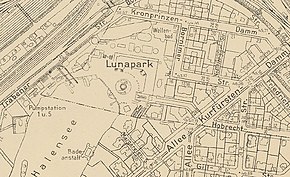Lunapark (Berlin)
The Lunapark (contemporary spelling: Luna Park) on Berlin's Halensee was located in what is now the Halensee district from 1909 to 1933 and was Europe 's largest amusement park at the time .
history
Emergence
In 1882, on the east bank of the Halensee, which was a popular open-air swimming pool at the time, the Wirtshaus am Halensee operated by the economist Saeger was built . Back then the Kurfürstendamm was a forest path on which families with Kremsern drove from the nearby Grunewald train station (today: Halensee train station ) to the Grunewald on Sundays . There was a break here and the motto was: "Families can make coffee here". As early as the 1890s, the inn premises included a fairground with a carousel, shooting and dice booths and a water slide where a pontoon-like boat rolled down the mountain to the lake.
opening

On May 14, 1904 the restaurateur August Aschinger opened the terraces at Halensee together with the former head chef of the Kempinski , Bernd Hoffmann, which was renamed Lunapark in 1909 . It was a modern fairytale palace with impressive towers and a large flight of stairs down to Halensee.
The wedding
The park contained all the hype attractions of the time, such as a water slide that ended in the lake, and a special attraction, a wave pool, which Berliners called the “hooker aquarium”, because here the ladies and gentlemen sitting at the edge of the pool in the latest swimwear presented.
Other attractions were a wobbly staircase (" Shimmy staircase") with a fan at the end that lifted the skirts of the ladies, as well as a mountain railway or a hippodrome . Based on the model of Coney Island in New York , an amusement park was created that offered sensations, adventure, danger, the illusion of the big wide world and the experience of the seemingly limitless possibilities of technology. Völkerschauen , the first escalator, large fireworks every night, theater, revues, jazz music, cabaret, but also dance tournaments and boxing matches were offered here. In 1926, the young Max Schmeling won his first title fight here. The restaurants had a capacity of 16,000 seats. There was the Bayern-Dorf, in which the beer “flowed freely”, or the Luna-Palais for more sophisticated demands. In the early years, the park had 50,000 visitors a day and considerably more on weekends. The one millionth visitor was received as early as 1910.
New opening
During the First World War and in the period of inflation , the number of visitors fell sharply and the facility was in a desolate state. On May 9, 1929, the Lunapark was opened a second time after a major renovation. However, the operators were no longer able to build on the old heyday.
The Lunapark on the screen
In 1930, the Lunapark was the setting for the sound film Who takes love seriously? (Germany 1931, directed by Erich Engel , leading actors: Jenny Jugo , Max Hansen ). A major part of the film plot takes place in a beauty contest (contest) in the Lunapark, the film scenes show almost all the attractions of the amusement park at that time.
The end
In October 1934 the Lunapark had to close for good and the whole area was demolished in 1935. Before that, the puppeteer Alfredo Bannenberg, persecuted by the new rulers, found shelter in the closed complex for a short time. The park was viewed by the Nazis as an eyesore, so it came in handy that the site was needed for the construction of Halenseestrasse , which was opened for the 1936 Summer Olympics , and a fast connection between the Olympic Stadium , the Deutschlandhalle , and the exhibition grounds at the radio tower and the competition venues to the south.
A community of showmen rented a new area in the Schönholzer Heide and revitalized the Lunapark as a dreamland there.
literature
- Claudia Puttkammer, Sacha Szabo: Greetings from the Luna Park. An archeology of pleasure. Amusement and amusement parks in the early twentieth century. WVB, Berlin 2007, ISBN 978-3-86573-248-4 .
- Erich Richard Majewski: Stories from the old Halensee, from the Lunapark and from the Kurfürstendamm. Verlag Bernd Ehrig, Berlin 1983, ISBN 3-548-74556-3 .
- Johanna Niedbalski: The whole world of pleasure . Berlin amusement parks from the 1880s to the 1930s. Bebra-Wissenschaftsverlag , Berlin 2018, ISBN 978-3-95410-212-9 .
Web links
- Lunapark. Private website on khd-Research with further information and pictures, accessed on April 28, 2020.
- Former Lunapark. District Office Charlottenburg-Wilmersdorf, accessed on April 28, 2020.
- Come on, my darling, in the Lunapark (August 1910) Song from the operetta Polish Economy , recording from 1910 (cylinder.de), accessed on April 28, 2020.
- Johanna Niedbalski: Lunapark in Berlin - extremely loud and incredibly full. In: Der Tagesspiegel . April 2, 2015, accessed April 28, 2020 .
Individual evidence
- ↑ A short summary of the film plot on a website of the German Historical Museum , accessed on September 10, 2002
- ↑ Lunapark at the BA Charlottenburg-Wilmersdorf , accessed on June 18, 2015.
- ^ Museum Association Pankow (ed.): Schönholzer Heide. From a place of amusement to a memorial. Berlin, 2007. pp. 16-18. ISBN 978-3-938414-47-7 .
Coordinates: 52 ° 29 ′ 49 ″ N , 13 ° 16 ′ 58 ″ E





